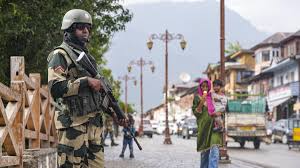Jump in troop deployment, counter-drone and air defence measures: How the Army is protecting Amarnath yatris after Pahalgam terror attack

After the tragic terror attack on a pilgrim bus near Pahalgam, the Indian Army has tightened security for the Amarnath Yatra. The attack on June 30 killed at least 10 people and left several injured. In response, security agencies launched a multi-layered protection plan for pilgrims.
This year’s Amarnath Yatra sees one of the most robust security setups in its history. Authorities have boosted troop presence, improved air defence, and deployed cutting-edge surveillance tools.
Thousands of Troops Guard the Yatra Routes
Over 50,000 security personnel now guard the Yatra. These include members from the Indian Army, CRPF, ITBP, J&K Police, and BSF.
The Baltal and Pahalgam routes each have two full Army battalions on duty. This means around 2,000 troops per route ensure 24/7 surveillance. Soldiers patrol every 5 km with Road Opening Parties (ROPs), bomb detection squads, and K9 units.
An officer on the ground said, “This isn’t just a pilgrimage. It’s a high-security operation. After the Pahalgam attack, our vigilance doubled.”
No-Fly Zones and Anti-Drone Systems in Place
From July 1 to August 10, drones, paragliders, and private aircraft are banned over the Yatra routes. The government declared these areas as no-fly zones to stop any airborne threats.
Security forces have deployed drone jammers and frequency disruptors to detect and disable rogue drones. Air defence systems are also active to counter low-flying aerial threats.
Experts believe this drone shield will prevent attacks like those seen in other conflict zones.
Smart Surveillance and Digital Monitoring
Authorities have placed hundreds of CCTV cameras along the entire route. These include night-vision and pan-tilt-zoom (PTZ) cameras connected to multiple control rooms.
Each pilgrim carries a QR-coded ID card with RFID tracking. Officials use this system to monitor movement and locate anyone in distress. Even pony handlers and animals wear tags linked to the database.
Joint control rooms in key zones bring Army, police, disaster relief, and medical units together for quicker response.
Convoys, Frisking, and Bullet-Proof Escorts
Pilgrims now travel in escorted convoys. Bulletproof vehicles like Marksman APCs guard high-risk stretches. Only registered vehicles are allowed, and they move during specific time slots.
Civilian traffic stops during convoy movement to avoid congestion or confusion. This improves safety for all travellers.
Frisking zones with metal detectors and baggage scanners are active at camps like Baltal and Nunwan. Soldiers also check ID cards and verify QR codes at each checkpoint.
A CRPF officer near Chandanwari said, “Every few minutes, foot patrols rotate. Drones watch over ridges while we secure the path.”
Medical Teams and Rescue Units on Standby
The government set up over 80 medical centres along the route. These clinics offer trauma care, oxygen support, and emergency first aid.
The Indian Air Force has helicopters on standby for airlift missions. Medical teams also assist pilgrims facing altitude sickness or injuries.
In a new move, female commandos handle frisking and protect women devotees. Their presence reassures pilgrims and promotes inclusivity.
Digital Safety for Every Step
Security isn’t just physical. It’s also digital. From the registration point to the final stretch, pilgrims remain under watch. RFID cards track movement. CCTV networks send alerts if any issue arises.
Officials can respond quickly to any emergency. Lost pilgrim? Medical help needed? The system flags it instantly.
Authorities also installed anti-sabotage sensors on roads to detect any underground movement or threats. Road-clearance drills happen daily before convoys depart.
Pilgrims Show Resilience Amid Tension
Despite recent violence, over 4 lakh people have registered for the Yatra this year. Many say they feel safe due to the heavy security presence.
A devotee from Maharashtra said, “We trust the forces. Their presence gives us confidence. We’ve come for blessings, not fear.”
The Army’s strong response has reassured many. Pilgrims now walk with faith—and without fear.
Conclusion: Protecting Faith with Force
The 2025 Amarnath Yatra highlights India’s resolve to protect its people. From high-tech drones to ground patrols, every security layer shows planning and precision.
This Yatra is now one of the most secure religious events in the world. It proves how faith, when supported by strong protection, can move forward—even in the face of terror.
As devotees continue their spiritual journey, the forces remain ever-watchful—shielding them from every threat, step by step.






